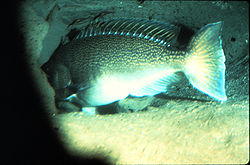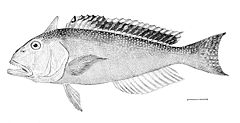- Tilefish
-
Tilefishes 
Blue blanquillo, Malacanthus latovittatus Scientific classification Kingdom: Animalia Phylum: Chordata Class: Actinopterygii Order: Perciformes Family: Malacanthidae Genera Branchiostegus
Caulolatilus
Hoplolatilus
Lopholatilus
Malacanthus
See text for species.Tilefishes, also known as blanquillo, are mostly small perciform marine fish comprising the family Malacanthidae. They are usually found in sandy areas, especially near coral reefs.[1]
Commercial fisheries exist for the largest species, making them important food fish. However, the American Food and Drug Administration warns pregnant or breastfeeding women against eating tilefish and some other fish due to mercury contamination. [2] [3] The smaller, exceptionally colorful species of tilefish are enjoyed in the aquarium.
Due to their low fecundities, commercially important species are threatened by overfishing via long-line and bottom trawling methods.
Contents
Physical description
The two subfamilies appear to be morphologically different, with members of Branchiosteginae having deep bodies, large heads and large, somewhat subterminal mouths. In contrast, members of Malacanthinae are slender with elongate bodies, smaller heads and terminal mouths.
Tilefish range in size from 11 centimetres (yellow tilefish, Hoplolatilus luteus) to 125 centimetres (great northern tilefish, Lopholatilus chamaeleonticeps) and a weight of 30 kilograms.
Both subfamilies have long dorsal and anal fins, the latter having 1-2 spines. The gill covers (operculum) have one spine which may be sharp or blunt; some species also have a cutaneous ridge atop the head. The tail fin may range in shape from truncate to forked. Most species are fairly low-key in colour, commonly shades of yellow, brown and gray. Notable exceptions include three small, vibrant Hoplolatilus species: the purple sand tilefish (H. purpureus), Starck's tilefish (H. starcki) and the redback sand tilefish (H. marcosi).
Tilefish larvae are notable for their generous complement of spines and serrations on the head and scales. This feature also explains the family name Malacanthidae, from the Greek words mala meaning "many" and akantha meaning "thorn".
Habitat and diet
Generally shallow-water fish, tilefish are usually found at depths of 50–200 metres in both temperate and tropical waters of the Atlantic, Pacific and Indian Oceans. All species seek shelter in self-made burrows, caves at the bases of reefs or piles of rock, often in canyons or at the edges of steep slopes. Either gravelly or sandy substrate may be preferred, depending on the species.
Most species are strictly marine; an exception is found in the blue blanquillo (Malacanthus latovittatus) which is known to enter the brackish waters of Papua New Guinea's Goldie River.
Tilefish feed primarily on small benthic invertebrates, especially crustaceans such as crab and shrimp. Mollusks, worms, sea urchins and small fish are also taken.
Behaviour and reproduction
Active fish, tilefish keep to themselves and generally stay at or near the bottom. They rely heavily on their keen eyesight to catch their prey. If approached, the fish will quickly dive into their constructed retreats, often head-first. The chameleon sand tilefish (Hoplolatilus chlupatyi) relies on its remarkable ability to rapidly change colour (with a wide range) to evade predators.
Many species form monogamous pairs, while some are solitary in nature (e.g., ocean whitefish, Caulolatilus princeps), and others colonial. Some species, such as the rare pastel tilefish (Hoplolatilus fronticinctus) of the Indo-Pacific, actively builds large rubble mounds above which they school and in which they live. These mounds serve as both refuge and as a micro-ecosystem for other reef species.
The reproductive habits of tilefish are not well studied. Spawning occurs throughout the spring and summer; all species are presumed not to guard their broods. Eggs are small (<2 mm) and made buoyant by oil. The larvae are pelagic and drift until the fish have reached the juvenile stage.
Species
There are forty-two species in five genera.
The family is further divided into two subfamilies: Branchiosteginae or Latilinae and Malacanthinae. Some authors regard these subfamilies as two evolutionarily distinct families (in which case the former subfamily is recorded as Branchiostegidae).
- Subfamily Malacanthinae
- Genus Branchiostegus
- Branchiostegus albus Dooley, 1978.
- Branchiostegus argentatus (Cuvier, 1830).
- Branchiostegus auratus (Kishinouye, 1907).
- Australia spotted handfish, Branchiostegus australiensis Dooley & Kailola, 1988.
- Ribbed tilefish, Branchiostegus doliatus (Cuvier, 1830).
- Branchiostegus gloerfelti Dooley & Kailola, 1988.
- Branchiostegus hedlandensis Dooley & Kailola, 1988.
- Branchiostegus ilocanus Herre, 1928.
- Red tilefish, Branchiostegus japonicus (Houttuyn, 1782).
- Branchiostegus paxtoni Dooley & Kailola, 1988.
- Freckled tilefish, Branchiostegus sawakinensis Amirthalingam, 1969.
- Zebra tilefish, Branchiostegus semifasciatus (Norman, 1931).
- Branchiostegus serratus Dooley & Paxton, 1975.
- Branchiostegus vittatus Herre, 1926.
- Branchiostegus wardi Whitley, 1932.
- Genus Hoplolatilus
- Chameleon sand tilefish, Hoplolatilus chlupatyi Klausewitz, McCosker, Randall & Zetzsche, 1978.
- Dusky tilefish, Hoplolatilus cuniculus Randall & Dooley, 1974.
- Yellow-spotted tilefish, Hoplolatilus fourmanoiri Smith, 1964.
- Pastel tilefish, Hoplolatilus fronticinctus (Günther, 1887).
- Hoplolatilus geo Fricke & Kacher, 1982.
- Yellow tilefish, Hoplolatilus luteus Allen & Kuiter, 1989.
- Redback sand tilefish, Hoplolatilus marcosi Burgess, 1978.
- Hoplolatilus oreni (Clark & Ben-Tuvia, 1973).
- Hoplolatilus pohle Earle & Pyle, 1997.
- Purple sand tilefish, Hoplolatilus purpureus Burgess, 1978.
- Starck's tilefish, Hoplolatilus starcki Randall & Dooley, 1974.
- Genus Malacanthus
- Quakerfish, Malacanthus brevirostris Guichenot, 1848.
- Blue blanquillo, Malacanthus latovittatus (Lacépède, 1801).
- Sand tilefish, Malacanthus plumieri (Bloch, 1786).
- Genus Branchiostegus
- Subfamily Latilinae
- Genus Caulolatilus
- Bighead tilefish, Caulolatilus affinis Gill, 1865.
- Bermuda tilefish, Caulolatilus bermudensis Dooley, 1981.
- Atlantic goldeye tilefish, Caulolatilus chrysops (Valenciennes, 1833).
- Blackline tilefish, Caulolatilus cyanops Poey, 1866.
- Bankslope tilefish, Caulolatilus dooleyi Berry, 1978.
- Reticulated tilefish, Caulolatilus guppyi Beebe & Tee-Van, 1937.
- Hubbs' tilefish, Caulolatilus hubbsi Dooley, 1978.
- Gulf bareye tilefish, Caulolatilus intermedius Howell Rivero, 1936.
- Grey tilefish, Caulolatilus microps Goode & Bean, 1878.
- Ocean whitefish, Caulolatilus princeps (Jenyns, 1840).
- Yellowbar tilefish, Caulolatilus williamsi Dooley & Berry, 1977.
- Genus Lopholatilus
- Great northern tilefish, Lopholatilus chamaeleonticeps Goode & Bean, 1879 (known as Golden Tile culinarily)
- Lopholatilus villarii Miranda-Ribeiro, 1915.
- Genus Caulolatilus
References
- ^ Discoverlife.org
- ^ FDA (1990-2010). "Mercury Levels in Commercial Fish and Shellfish". http://www.fda.gov/food/foodsafety/product-specificinformation/seafood/foodbornepathogenscontaminants/methylmercury/ucm115644.htm. Retrieved 2011-09-14.
- ^ Melody Joy Kramer (October 17, 2006). "Fish FAQ: What You Need to Know About Mercury". http://www.npr.org/templates/story/story.php?storyId=6283905. Retrieved 2011-09-14.
- Froese, Rainer, and Daniel Pauly, eds. (2006). "Malacanthidae" in FishBase. February 2006 version.
Further reading
- Eol.org
- Acero, A. and Franke, R., (2001)., Peces del parque nacional natural Gorgona. En: Barrios, L. M. y M. Lopéz-Victoria (Eds.). Gorgona marina: Contribución al conocimiento de una isla única., INVEMAR, Serie Publicaciones Especiales No. 7:123-131.
- Breder, C.M. Jr., (1936)., Scientific results of the second oceanographic expedition of the "Pawnee" 1926. Heterosomata to Pediculati from Panama to Lower California., Bull. Bingham Oceanogr. Collect. Yale Univ., 2(3):1-56.
- Béarez, P., 1996., Lista de los Peces Marinos del Ecuador Continental., Revista de Biologia Tropical, 44:731-741.
- Castro-Aguirre, J.L. and Balart, E.F., (2002)., La ictiofauna de las islas Revillagigedos y sus relaciones zoogeograficas, con comentarios acerca de su origen y evolucion. En: Lozano-Vilano, M. L. (Ed.). Libro Jubilar en Honor al Dr. Salvador Contreras Balderas., Universidad Autonoma de Nuevo León:153-170.
- Dooley, J.K., (1978)., Systematics and biology of the tilefishes (Perciformes: Branchiostegidae and Malacanthidae), with descriptions of two new species., U.S. Nat. Ocean. Atmos. \.
Categories:- Malacanthidae
- Edible fish
- Commercial fish
- Megafauna
- Subfamily Malacanthinae
Wikimedia Foundation. 2010.



